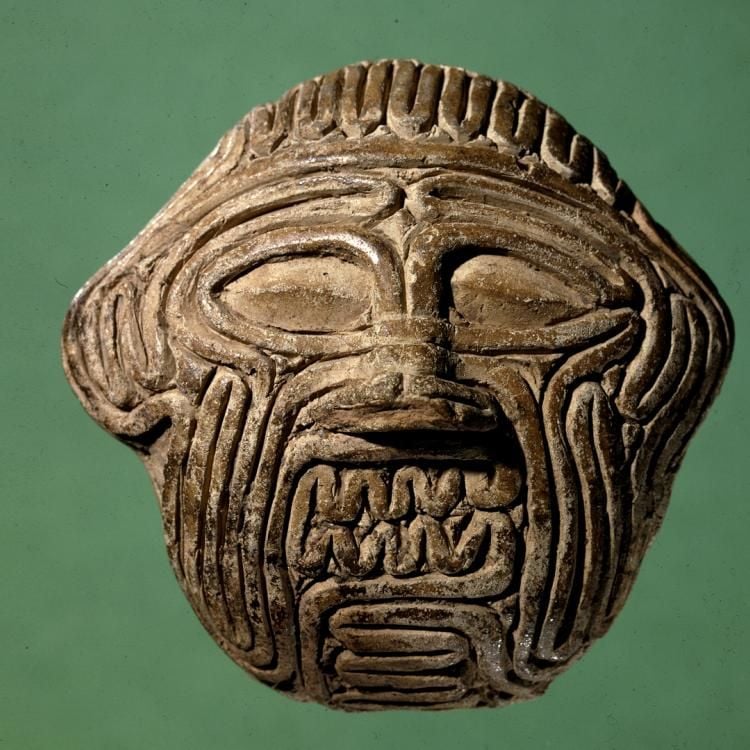To help you on your trail
Follow this logo to find the objects

Choose one of two trails, looking at objects that have a connection with LGBTQ+ history.
There are two Desire, love, identity trails, depending on how much time you have. View detailed descriptions of the objects featured in each of the trails below. You can also download the leaflet with both trails, which includes the route, images with a brief description, and the Museum map.
Fifteen-object trail – this trail requires about 60–75 minutes. The objects have been arranged to create an efficient route. However, you don't need to follow this order.
Three-object trail – this trail is ideal if you only have 30 minutes to spare.
Audio commentaries – you can download audio commentaries for each of the objects on both trails to listen to on your own device. Search for 'Desire, love, identity' in Apple Music, YouTube Music or Spotify. A transcript of the object trail is also available.
The Museum regularly lends objects to other institutions around the world. This means that from time to time, some of the objects that are part of the trail may be temporarily removed from display. Some galleries will close at short notice due to refurbishment or unforeseen circumstances. This may impact on step-free access. See the list of planned closures for the latest information.
Fifteen-object trail
1. The Discus Thrower (Room 1)
This sculpture is often assumed to be an athlete. However, rather than being a single figure, as we view it today, the discus thrower may have been part of a larger group of statues with a mythological theme. The beautiful youth Hyacinth was tragically struck and killed by a discus thrown by his lover, the god Apollo. The discus was blown off course by the jealous god of the West Wind, Zephyr.
About the Discus Thrower
Maori treasure box
2. Maori treasure box (papahou), Aotearoa, New Zealand (Room 1)
This intricately carved wooden box, inlaid with shell and greenstone, features male and female figures intertwined in sexual union. One scene, on the side of the box shown here, blurs sexual boundaries and gender roles.
About the Maori treasure box (papahou)
Statue of Ganymede
3. Statue of Ganymede (Room 1)
In mythology, the god Zeus (or Jupiter) was overcome by desire for the beautiful youth Ganymede. In Greek mythology the gods were subject to the same desires as humans. Zeus (Jupiter to the Romans) took on various forms to satisfy his lust for both men and women. He took the form of an eagle to abduct Ganymede who later became the god's cupbearer.
About the statue of Ganymede
A Maya ruler
4. A Maya ruler (East stairs)
This image of a male Maya ruler was once assumed to be a woman by European scholars. He is dressed as a youthful maize deity who combines male and female genders. This gender duality may reflect his power as a ruler, both in his duty to perform successful fertility rituals to nurture his people, and in his ability to communicate with divine beings.
About the image of a Maya ruler
N'domo masquerade mask
5. N'domo masquerade mask (Room 25)
In many African cultures, gender and gendered roles are fixed through rituals. N'domo masks are worn by men but the masks can be male, female or androgynous.
About the N'domo masquerade mask
Queen of the Night
6. Queen of the Night (Room 56)
The Mesopotamian deity Ishtar had the power to assign gender. Some of her cult members seem to have been considered woman-like men who did forbidden things to delight her. Ishtar is a fascinating deity who collapses boundaries and celebrates the ambiguous territory between genders.
Please note: this object is currently part of a touring exhibition and will not be on display until 2025. Several small terracotta figures depicting Ishtar are on display in the case that usually houses the Queen of the Night.
About Queen of the Night
Epic of Gilgamesh
7. Epic of Gilgamesh (Room 56)
This famous poem describes how King Gilgamesh and the Wildman Enkidu became close friends. The text describes their relationship in erotic terms. The two men have various heroic adventures, including killing a demon called Huwawa.
Epic of Gilgamesh
Hor and Suty
8. Hor and Suty (Room 61)
This inscribed stela (stone tablet) is dedicated to two ancient Egyptian men, Hor and Suty. It has been argued that they may have been a male couple, but the evidence suggests they were twins. It is difficult to look back at the distant past – into ancient cultures very different to our own – and to find definitive insights into personal and individual realities of love and desire. Written evidence tells us that the ancient Egyptians recognised the existence of same-sex desire.
Hor and Suty
The Warren Cup
9. The Warren Cup (Room 70)
Decorated with two scenes of male lovers, this Roman wine cup could not be displayed publicly for most of the 20th century. Homosexuality was illegal in England and Wales until July 1967.
The Warren Cup
Hadrian and Antinous
10. Hadrian and Antinous (Room 70)
The beautiful youth Antinous was the emperor Hadrian's lover. When Antinous drowned in AD 130, Hadrian made him into a god and publicly commemorated him across the empire.
Hadrian and Antinous
Athenian wine amphora
11. Athenian wine amphora (Room 69)
These vessels, a wine cup and amphora (or vase), were made in Athens over 2,500 years ago. They would have been used at all-male drinking parties known as symposia. Intimate sexual relationships between men and youths were an accepted part of life in several ancient Greek city states, particularly in Athens during the 6–4th century BC.
Athenian wine amphora
Sappho
12. Sappho (Room 69)
This ancient Greek water jar, made in Athens around 450 BC but found in Rhodes, depicts a seated woman looking at an open scroll. This may be the Greek poet Sappho. Although little is known for certain about Sappho's life, her poems gave a voice to female desire that still resonates today.
Sappho
Saint Sebastian
13. Saint Sebastian (Room 40)
Saint Sebastian is believed to have been martyred around AD 288, during a period of Roman persecution of Christians. In recent times Saint Sebastian has become a gay icon inspiring filmmakers, writers and artists. The imagery of him which has become so influential today originated in medieval and Renaissance Europe.
Saint Sebastian
Ladies of Llangollen
14. Ladies of Llangollen (Room 47)
Lady Eleanor Butler and Sarah Ponsonby fled Ireland together in 1778. They set up home in North Wales, challenging the conventions of the era and living the life of their choice there for 50 years.
Ladies of Llangollen
The Ain Sakhri Lovers
15. The Ain Sakhri Lovers (Room 51)
This object dates from about 11,000 years ago. It's the oldest known sculpture of two lovers. The genders of the figures are unclear and open to interpretation. All that remains is the reflection of their love.
The Ain Sakhri Lovers
Hadrian and Antinous
1. Hadrian and Antinous (Room 70)
The beautiful youth Antinous was the emperor Hadrian's lover. When Antinous drowned in AD 130, Hadrian made him into a god and publicly commemorated him across the empire.
About Hadrian and Antinous
Queen of the Night
2. Queen of the Night (Room 56)
The Mesopotamian deity Ishtar had the power to assign gender. Some of her cult members seem to have been considered woman-like men who did forbidden things to delight her. Ishtar is a fascinating deity who collapses boundaries and celebrates the ambiguous territory between genders.
Please note: this object is currently part of a touring exhibition and will not be on display until 2025. Several small terracotta figures depicting Ishtar are on display in the case that usually houses the Queen of the Night.
About the Queen of the Night
Ladies of Llangollen
3. Ladies of Llangollen (Room 47)
Lady Eleanor Butler and Sarah Ponsonby fled Ireland together in 1778. They set up home in North Wales, challenging the conventions of the era and living the life of their choice there for 50 years.
About the Ladies of Llangollen
Find out more
The Museum's Prints and drawings department holds many works on paper with an LGBTQ+ connection. You can explore the Collection online or make an appointment to view works in the Prints and Drawings study room.
Visit Google Arts to find out more about the objects in this trail and LGBTQ+ histories in the British Museum collection.
RB Parkinson's A Little Gay History: Desire and Diversity across the World (British Museum Press, 2013) focuses on 40 objects in the British Museum collection, including most of those featured in this trail.
The following books provide more information about individual objects.
- Dyfri Williams, The Warren Cup (British Museum Press, 2006)
- Ian Jenkins, The Discobolus (British Museum Press, 2012)
- Dominique Collon, The Queen of the Night (British Museum Press, 2005)





